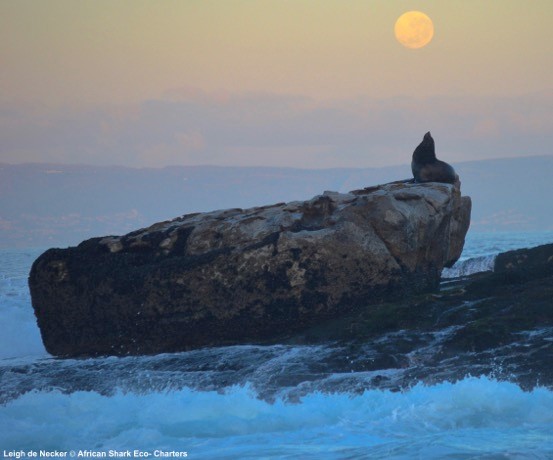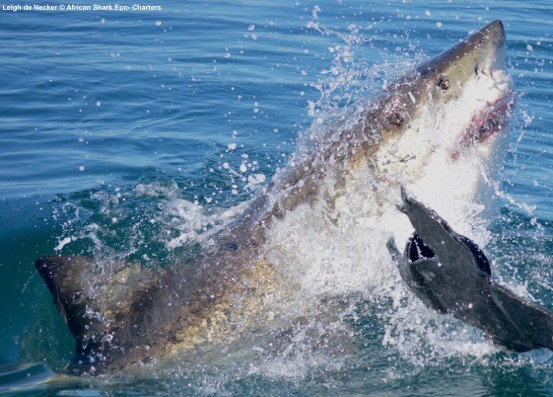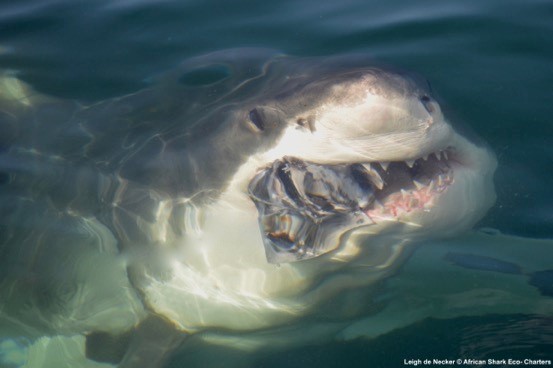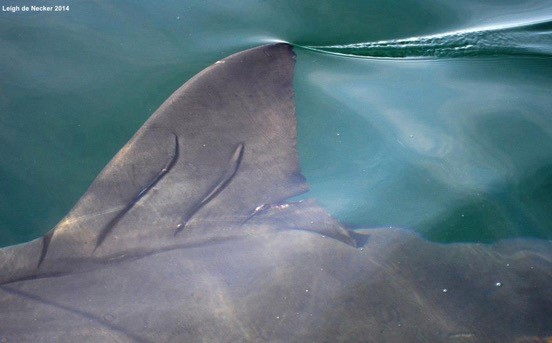Marine Life & Conservation
Summing up the surprises of the 2016 white shark season, Seal Island, False Bay
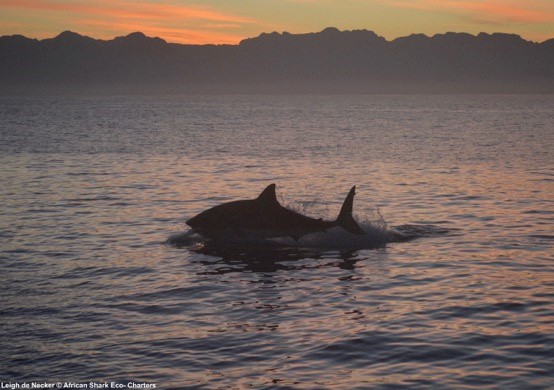
White sharks typically visit False Bay’s Seal Island to take advantage of vulnerable young Cape fur seal pups when they start entering the water to feed. This is generally between March and September; however, this season showed a number of deviations from the expected norms. We took a trip to the Island towards the end of January and before we even had any bait in the water, we had seen a shark. We were beyond excited by the chance of having an early start to the season. This was the first of many unexpected surprises the season had to offer. For February and March, we had amazing shark activity around our boat, seeing an average of 4 sharks a day and still enjoying the late summer, early autumn warm sunny days on the water.
But before we got too comfortable, leaving the sharks to do all our work for us, by the end of April and throughout May, they had simply vanished from Seal Island. There were some really bizarre theories as to where they were and why from crew, clients, fishermen and local shark nuts, but even today the mystery of their temporary disappearance remains. The crew had placed all their bets on the exact date that the sharks would return, and just before we had begun to completely lose our minds (and jobs) the sharks started making an appearance again within the first week of June.
I nearly jumped right off the boat seeing the first shark breach (I always go mad seeing a shark breach, every breach is different and it simply never gets old), but this was a combination of that excitement coupled with relief at the sign that “the shark drought” had potentially come to an end. July was an incredible month with both breaching activity as well as shark activity around the boat. Despite the fact that during this time the sharks were always around, every day, every trip, every hour, in fact, was different. Obviously the breaching and overly enthusiastic sharks around our boat are always a treat, but there were a few really memorable, standout moments this season. Firstly, a shark over 4 m in length, coming fully out of the water attacking a kelp gull just 3 m away from our boat, having the crew and clients very much in the splash zone (this just minutes after I had told a client how breaching was rare in the afternoon, and that I had never seen a shark go for a bird). On another afternoon in July, we had crystal clear waters with over 10 different sharks around our boat, flying at our bait and decoy consistently from all different angles! It was the best kind of chaos!
Further, seeing some of our favourite sharks returning to the boat over consecutive days, a special mention (and thanks) to some of the stars this year: “Zebra,” “Dodgey L,” “Prop,” “Jika,” “Patches,” “Captain MF Hook” “Stumpy Freddy,” “The one with the bent dorsal (Orca/Nemo)” and a few OCEARCH tagged sharks, including “Vindication” and “Maureen.” Of course once we’ve named them, we get very emotionally attached. They become like a puppy dog, really cute but with rather sharp teeth, eating all your personal belongings. When naming and identifying individual white sharks, its usually from a distinguishing feature, scar or behaviour. However, it is incredible to see how much their behaviours’ vary, not only between the different individuals, but even for a particular shark on a particular day. With the number of times I’ve seen a shark put all its effort into the most magnificent breach, only for its targeted seal prey to get away, its not difficult to believe that a shark can have a bad day. Sometimes we’d see sharks hunting and making successful kills still visiting our boat and scavenging at our bait. Surprisingly, and unlike me, sharks don’t seem to have bottomless pits for stomachs, and therefore once they have eaten, they are often uninterested in us, or our bait. Maybe it’s a class thing – why would you eat a stale sandwich when there is fillet steak on offer? It may be more expensive, but totally worth it right?
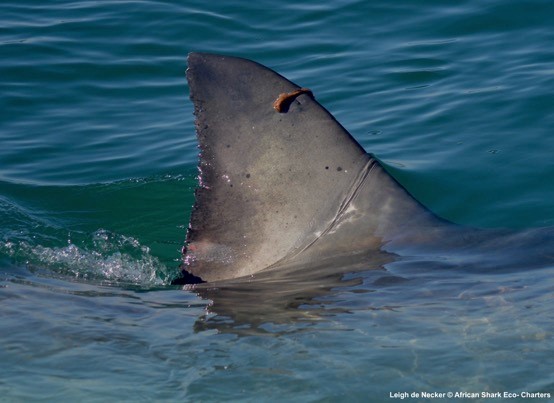
“Captain MF Hook”- I only have a picture of her dorsal fin because she was simply too big to fit in the frame at a massive 5 m in length (we’re going to need a bigger boat).
Another highlight this season was the revisit of the shark “Prop,” named for the propeller scars running along the leading edge and across her dorsal fin. I had first seen her in 2014 when the scars were still fresh and an unmistakable identifying feature. If it weren’t for her stumpy pectoral fin and the fact that she is a particularly large girl, closing in on 5 m, we would not have even recognised her this year. The scars on her dorsal fin had healed up so well being no more than very faint lines across her dorsal fin.
A simple yet perfect example of the perfect predator, proving just how resilient they are and that their ability to heal and recover, is beyond comprehension. There is never a dull moment working with these animals; the more we try to understand them, the more we are left with a whole new set of questions rather than answers. Every day, heading out to Seal Island, you don’t know what you’re going to get. By describing this season as “surprising” “unusual” “unexpected” “unpredictable” is quite appropriate really, because all these words fundamentally define and describe “nature.” If nature were predictable, it would not be as fascinating as it is. To us, what appeared to be “inconsistencies” in the season, served as an important reminder of just how dynamic nature is and it has allowed us to continue marvelling in the mystery that is the white shark.
Leigh is the On-board Marine Biologist for African Shark Eco Charters. Find out more at www.ultimate-animals.com.
Marine Life & Conservation
Paul Watson Released as Denmark Blocks Japan’s Extradition Bid

Renowned anti-whaling activist Paul Watson has been released from custody in Greenland after spending five months in detention. Denmark’s Justice Ministry rejected Japan’s request for his extradition, citing insufficient guarantees that his time already served in custody would be credited against any potential sentence.
The 74-year-old Canadian-American was arrested on July 21 in Nuuk, Greenland’s capital, when his ship docked to refuel. His arrest was based on a 2012 Japanese warrant related to a 2010 encounter in Antarctic waters. Japan alleged Watson obstructed operations and caused damage to a whaling research ship during efforts to disrupt illegal whaling. Watson has consistently denied these claims, maintaining his commitment to marine conservation.
Denmark, which oversees extradition matters for Greenland, concluded that while the legal conditions for extradition were met, the lack of assurances from Japan regarding time-served credit made extradition untenable.
In a video shared by his foundation, Watson expressed gratitude and relief, saying, “After five months, it’s good to be out… and good to know they’re not sending me to Japan.” He added that the most difficult part of his time in custody was being separated from his two young sons.
Watson is a pioneering figure in marine conservation, known for founding the Captain Paul Watson Foundation in 2022 after decades of activism with the Sea Shepherd Conservation Society. His bold efforts to defend marine life have earned him widespread support, including from celebrities and conservationists. His work has also been featured in the acclaimed reality TV series Whale Wars.
Watson’s lawyer, Jonas Christoffersen, praised the decision, stating, “We are happy and relieved that Paul Watson is now free.” He added that Watson is eager to reunite with his family and continue his vital work.
The arrest occurred while Watson’s vessel, the M/Y John Paul DeJoria, was en route to the North Pacific with a team of 26 volunteers to intercept a Japanese whaling ship. His foundation described the arrest as politically motivated and emphasized that Watson’s actions were focused on ending illegal whaling practices.
Japan resumed commercial whaling in 2019 after leaving the International Whaling Commission, asserting that whale meat is a cultural tradition. Conservationists, however, continue to challenge these practices, highlighting their impact on marine ecosystems.
Despite the challenges, Watson remains steadfast in his mission to protect marine life and bring attention to whaling practices. His dedication to ocean conservation has made him a globally respected advocate for the environment.
Marine Life & Conservation
12 Days of Zero-Waste Fish-mas

This holiday period, the Marine Conservation Society, the UK’s leading ocean membership charity, invites you to make some simple changes to eating fish this Christmas to help our seas.
Dr Kenneth Bodles, Head of Fisheries and Aquaculture at the Marine Conservation Society, said, “During the festive season, our consumption increases, but so does waste. Sustainability isn’t just about where food comes from – it’s also about how you use it. By reducing waste and making the most out of your seafood, you’re not only taking steps to be more ocean-friendly, but can also help to cut costs during what is often one of the most expensive times of the year”.
The Marine Conservation Society has compiled twelve tips on how to consume seafood sustainably with zero-waste this Christmas:
Buy whole fish instead of fillets
Instead of fillets, consider buying whole fish such as salmon, hake, or lemon sole. By adopting a “nose to tail” approach with cooking, whole-baked fish not only feeds a crowd, but also helps to minimise waste and maximise sustainability by using up every part of the animal, including bones, skin, and fat.
Make fish stock
Leftover fish bones or shells can be put to good use by boiling them to make a nourishing fish stock or bisque. This can be frozen and preserved for later use and makes for a flavourful base in a soup.
Make your own fish pâté
Avoid waste by turning leftover fish, such as smoked mackerel or salmon, into a delicious pâté by blending with cream cheese and lemon. Perfect when paired with crackers.
The sustainability of salmon and mackerel varies depending on where and how it is caught or farmed. For more information on green-rated options, check the charity’s Good Fish Guide.
Buy frozen
By purchasing seafood that is frozen or vacuum-packed, this helps to reduce waste by extending the shelf life of your food.
Fish pie
If you’re wondering what to do with leftover cooked fish, why not opt for a classic fish pie with mashed potatoes, leeks, and a cheesy sauce? A sure crowd pleaser on Boxing Day.
Use the head
Don’t forget the fish head! The meat is incredibly tender and flavourful. The charity recommends a cod’s head curry or recreating Fallow’s renowned cod’s head in siracha butter.
By stretching your ingredients further, not only is this a more sustainable way to enjoy seafood, but also cost-effective by repurposing leftovers and cooking creatively.
Boxing Day brunch
Mix leftover kippers or smoked salmon with scrambled eggs for a tasty, zero-waste, Boxing Day brunch.
For best choice, make sure you buy kippers, or herring, from the North Sea and the North Irish Sea.
Zero-waste storage
A top tip from the Marine Conservation Society to avoid waste is freezing fish offcuts to save for future use.
Crisp up the skin
Even leftover fish skin can be turned into a quick savoury snack by crisping it up in an air fryer with a little olive oil and salt.
Anchovies two ways
Leftover anchovies can either be blended with butter to make a delicious anchovy butter or tossed into pasta for a hit of umami flavour.
The charity recommends opting for anchovies caught in the Bay of Biscay for best choice.
Fishcakes
For an easy, zero-waste meal, leftover seafood trimmings can be mixed with mash and fried in breadcrumbs to make fishcakes.
Pickled mussels
Try pickling mussels in 1:1 vinegar and water, with a dash of sugar for a sustainable, zero-waste snack that can be enjoyed well beyond the festive season.
Mussels farmed in the UK are a seafood superhero. Grown using low-impact methods and harvested by hand, they get all the food they need from the sea around them. This makes them one of the most sustainable, ocean-friendly, and cost-effective seafood options.
Players of People’s Postcode Lottery have raised £6.6M towards the Marine Conservation Society’s vital work in making seafood more sustainable.
Laura Chow, Head of Charities at People’s Postcode Lottery, said: “Fish is a festive favourite for many, but making sustainable choices when it comes to how we buy and eat seafood makes all the difference for our ocean. Support from players of People’s Postcode Lottery has helped the Marine Conservation Society further its sustainable seafood work, so that we can all enjoy healthier, better protected seas.”
The Marine Conservation Society encourages you to make sustainable seafood choices a year-round habit, not just for Christmas. To check how sustainable the seafood on your plate is, you can visit the charity’s Good Fish Guide. The Guide helps consumers and businesses identify the most sustainable seafood using a simple traffic light system, based on where and how species are caught or farmed. Green is the best choice, amber means improvements are needed, and red indicates fish to avoid buying.
Zero-waste gift idea
Why not embrace a zero-waste Christmas by gifting a membership to support marine conservation? It’s a meaningful, low-waste gift that helps protect our ocean for generations to come. Memberships start from as little as £5 a month – the price of a sandwich and drink from your local coffee shop.
Find the latest sustainable seafood advice for wild-caught and farmed seafood on the Good Fish Guide, downloadable to your phone from www.mcsuk.org/goodfishguide.
-

 News2 months ago
News2 months agoIconic SS United States to become the World’s Largest Artificial Reef
-

 News3 months ago
News3 months agoBook Review – 52 Assignments: Underwater Photography
-

 Gear News3 months ago
Gear News3 months agoDYNAMICNORD – New German diving brand enters the British market
-

 News3 months ago
News3 months agoExploring Cenote El Pit: A Diver’s Dream
-

 Gear News3 months ago
Gear News3 months agoTry BARE drysuits (and maybe even win one!) this Friday with Sea & Sea at North West Dive Fest
-

 Marine Life & Conservation3 months ago
Marine Life & Conservation3 months agoBook Review: Coral Triangle Cameos
-

 Blogs2 months ago
Blogs2 months agoDive the Egyptian Red Sea this Autumn with Regaldive
-

 News3 months ago
News3 months ago2024 Ocean Art Underwater Photo Competition Announced



